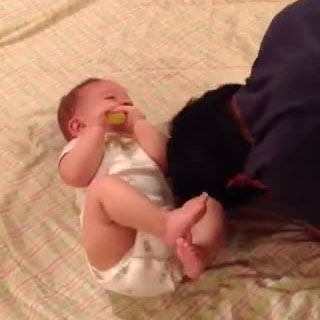About this Video
In this video we see a spontaneous playful interaction between 6-month-old Wayne and his grandfather (Papa). Many families play games like this, which are important both to children’s sense of belonging and their ability to communicate with others.
For Papa, playtime is also a time to start teaching Wayne the family’s heritage language. Although their family members speak primarily English, some older relatives grew up speaking Maskoke (also called Creek), an indigenous American language. As part of an effort to preserve the language, younger family members attend classes to learn Maskoke and make a point of using it in daily life, particularly in interactions with the children.
As the video begins, Wayne is lying down and chewing on a teething toy while Papa pushes him with his head, rolling the baby onto his right side and making him giggle and squeal with delight. When Papa moves away, Wayne rolls back and makes eye contact with him. Papa then waves, says “hensci” (prononunced hens-CHAY, which means “hello” in Maskoke), and rolls Wayne onto his side again. They repeat this routine several times.
This game involves continuous contingent interaction, a kind of turn-taking essential to children’s language development and social emotional development. “Continuous” means that the interaction keeps going as long as both participants are interested. “Contingent” means that each participant is responding to something the other person has done.
Interactions such as the one shown here are typical for babies and their families, but parents may not be aware of how important they are. Taking turns—observing and responding—is basic to all communication. All his life, Wayne will need to pay attention to cues from others that tell him what they want or need, and he will need to know how to get and hold their attention so they understand what he’s trying to communicate. Such cycles help a child understand cause-and-effect relationships (e.g., “When I smile and laugh, Papa keeps doing fun things!”). Such interactions also help babies bond with family members. Both Wayne and Papa clearly enjoy their game, and this shared enjoyment lets Wayne know that Papa cares for him. As children grow older, continuous contingent interactions enable them to make and keep friends, gather information in school, play games and sports, and collaborate with others to solve problems.
Although it is difficult to say much about Wayne’s receptive language development, the video shows that Papa is helping him understand that the word “hensci” and a wave of the hand are forms of greeting—important knowledge in his family and in the wider community.
Video
Transcript
The speech in this clip is limited to Papa saying “hensci,” so a transcript is not provided.
Illinois Early Learning Guidelines for Children Birth to Age Three & How They Were Met
This list shows how Wayne’s actions in the video relate to some standards in the birth-to-three guidelines.
Self-Regulation: Foundation of Development
Emotional Regulation
Children demonstrate the emerging ability to identify and manage the expression of emotion in accordance with social and cultural contexts.
- Indicators for children (birth – 9 months): Vocalizes and uses facial cues to get caregiver’s attention, e.g., cries, gazes, initiates eye contact
- Action: Wayne made an “ahhhh” sound while making eye contact with Papa.
Developmental Domain 1: Social & Emotional Development
Relationship with Adults
Children demonstrate the desire and develop the ability to engage, interact, and build relationships with familiar adults.
- Indicators for children (birth – 9 months):
- Uses signals to communicate needs, e.g., crying, body language, and facial expressions
- Begins to engage in simple, back-and-forth interactions with a familiar adult, e.g., plays “peek-a-boo,” babbles in response to an adult speaking and repeats this interaction
- Action: Wayne laughed and turned toward Papa to signal that he wanted to continue the game. He continued the back-and-forth interaction by turning back to make eye contact with Papa several times.
Developmental Domain 3: Language Development, Communication, & Literacy
Social Communication
Children demonstrate the ability to engage with and maintain communication with others.
- Indicators for children (birth – 9 months): Smiles and uses other facial expressions to initiate interactions with caregiver
- Action: Wayne responded to Papa by smiling and laughing, which showed that he enjoyed their two-way interaction, and by turning back to look at him.


